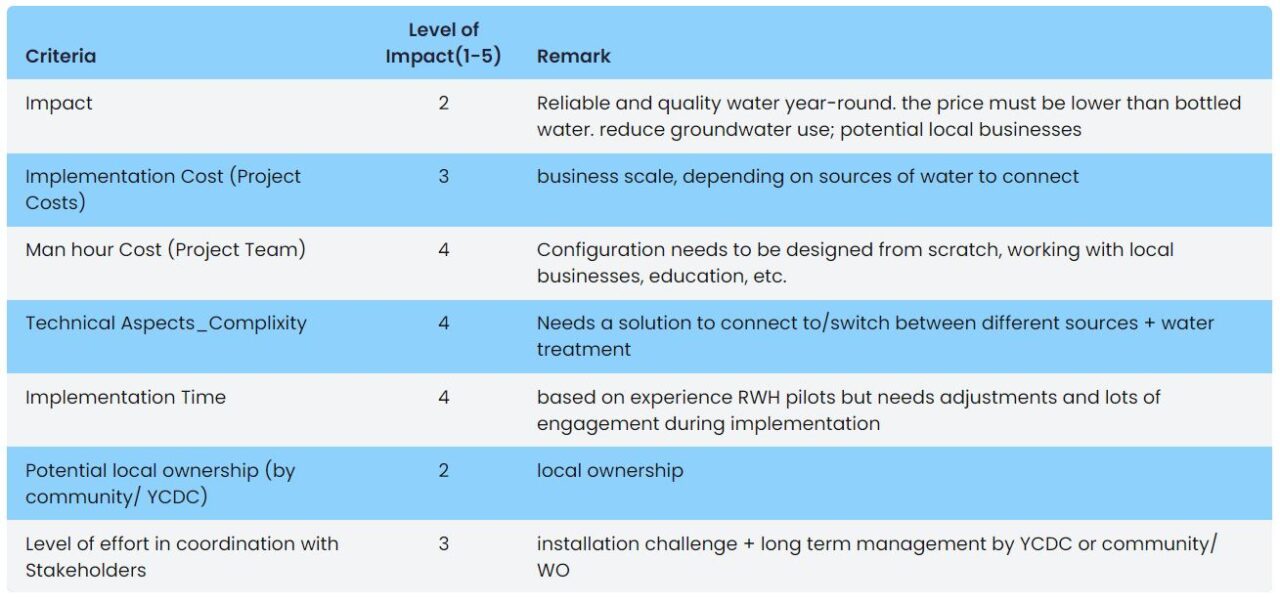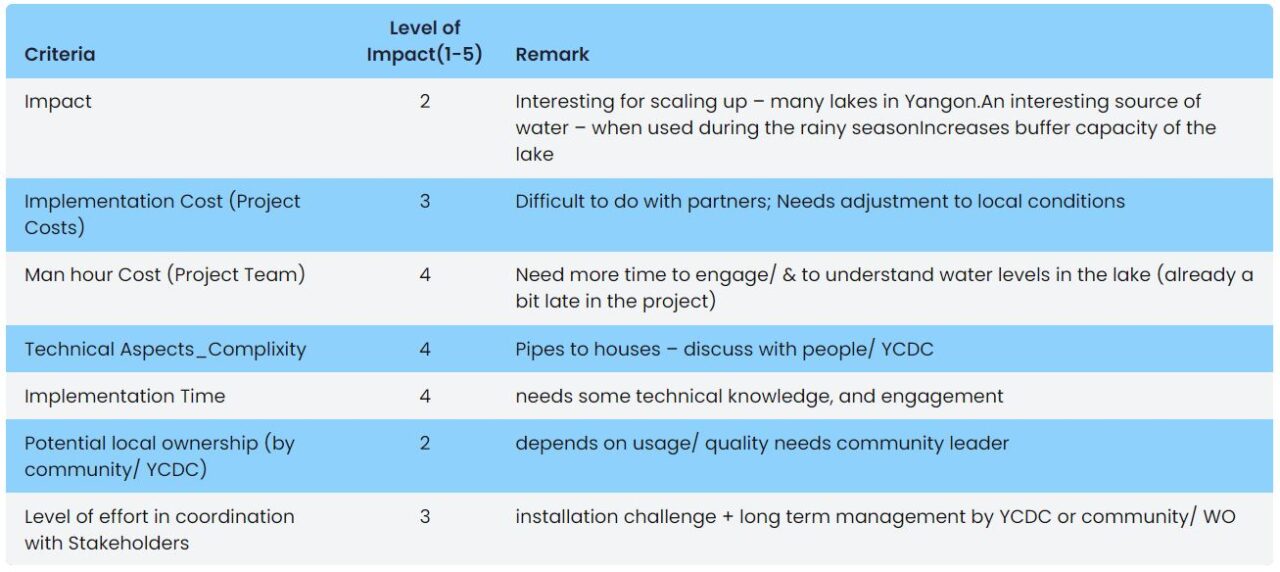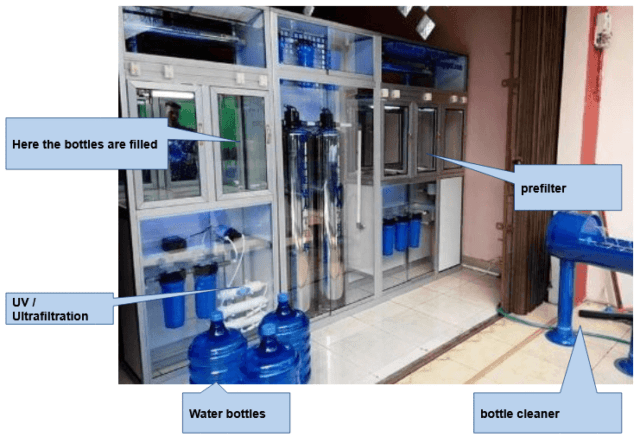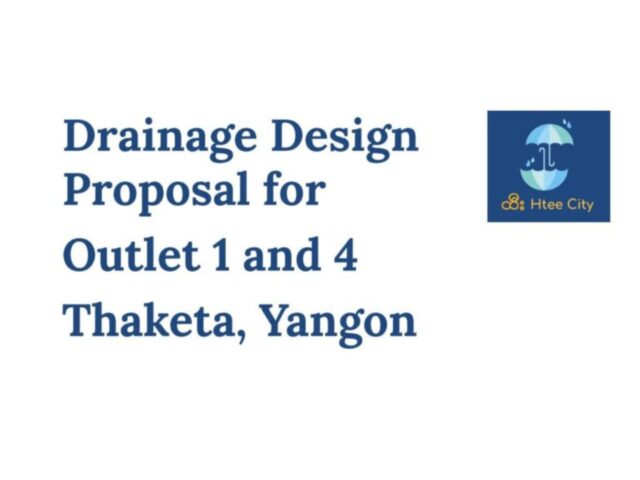A water supply system can have different scales; from household level (individual rainwater harvesting systems) to larger-scale systems that serve more people. Here we will describe two types of communal water supply systems:
- a communal rainwater harvesting system for a specific group within the community (e.g. a school, a few households, or one street), run by the users themselves for their own use.
- a water kiosk, run by community members or a social enterprise to sell water to the community
For both options, the source of water can be different. Relevant sources are: rainwater, groundwater (deep or shallow), piped water (YCDC pipelines), water from the retention lake. The benefits of communal water supply systems are:
- Reliable drinking water supply by diversification of water sources, towards resilience in water supply
- Community driven or commercial water self-supply system
- connect with existing water sellers (operation)
- Potentially better quality (although we found no strong issues with current bottled water)
- Cheaper than current bottled water (Currently, a high percentage of daily expenses is spent on drinking water and some people cannot afford bottled water (informal settlers) and drink water of low quality such as water from retention lake and rainwater)
- This system can be an ‘in-between solution’ before all houses are connected to piped water
Impact/Relation to Climate Resilience/Adaptation
- Reduced risks of temporary flooding due to frequent rainfall events (twice a month). For example, with tanks of 2000 liter (a common size) and a roof of 25 M2, a rainfall analysis results in a reduced flow of 40m3 per household per year. When scaled up, this means 2 million m3 of rainfall captured for Thaketa, which is 5% of total yearly rainfall.
- Reduced risks of temporary flooding due to medium and heavy impact events (once in two years). For example, with a tank of 2000 L and 25 m2 roof area the first 80 mm of a rainfall event is captured, which greatly reduces the risk of flooding if sufficient area is equipped with a capturing system.
- Repletion groundwater aquifer with up to 40m3 less extraction per household per year with a tank of 2000 liter and a roof of 25 m2
- Reduces risk of downstream flooding
- Improved water supply – rainwater is of better quality than surface water and shallow well water
- Improved water supply – rainwater is free (after the investment of the collection system) and can directly be used (with or without an extra filter)
- Improved water affordability: estimated savings of 26,000 kyat per household per year, when the rainwater is used as drinking water
- Strengthen the ‘value of water, awareness on water use and water sources
Impact of interventions on community
If the communal water supply system is installed within an institutional building (eg, schools, offices, etc.) it can supply enough water for the whole building. If it is designed with community households, it’s not that many for domestic use. But if all water is reserved for drinking water, a significant amount of people can be reached.
As for the strategy /scalability of the intervention, it is scalable with replication to other schools, paid by YCDC, NGOs, schools themselves, or CSR by integrating in YCDC’s daily work of mainstreaming climate adaptation activities.
Multi-Criteria Analysis for Water kiosks, incl. operation

| Criteria | Level of Impact(1-5) | Remark |
|---|---|---|
| Impact | 2 | Reliable and quality water year-round. the price must be lower than bottled water. reduce groundwater use; potential local businesses |
| Implementation Cost (Project Costs) | 3 | business scale, depending on sources of water to connect |
| Man hour Cost (Project Team) | 4 | Configuration needs to be designed from scratch, working with local businesses, education, etc. |
| Technical Aspects_Complixity | 4 | Needs a solution to connect to/switch between different sources + water treatment |
| Implementation Time | 4 | based on experience RWH pilots but needs adjustments and lots of engagement during implementation |
| Potential local ownership (by community/ YCDC) | 2 | local ownership |
| Level of effort in coordination with Stakeholders | 3 | installation challenge + long term management by YCDC or community/ WO |
Option (1) Increase (sustainable) use of lake – pipes, maybe pump. One of the possible water sources is the retention lake in Ward 5.
Multi-Criteria Analysis for use of the lake as a water source, incl. operation

| Criteria | Level of Impact(1-5) | Remark |
|---|---|---|
| Impact | 2 | Interesting for scaling up – many lakes in Yangon.An interesting source of water – when used during the rainy seasonIncreases buffer capacity of the lake |
| Implementation Cost (Project Costs) | 3 | Difficult to do with partners; Needs adjustment to local conditions |
| Man hour Cost (Project Team) | 4 | Need more time to engage/ & to understand water levels in the lake (already a bit late in the project) |
| Technical Aspects_Complixity | 4 | Pipes to houses – discuss with people/ YCDC |
| Implementation Time | 4 | needs some technical knowledge, and engagement |
| Potential local ownership (by community/ YCDC) | 2 | depends on usage/ quality needs community leader |
| Level of effort in coordination with Stakeholders | 3 | installation challenge + long term management by YCDC or community/ WO |
Multi-Criteria Analysis for Communal RWH system
It is the same or very similar as household RWH pilots but bigger/combined and depends on the role of the project vs possible partner.

| Criteria | Level of Impact(1-5) | Remark |
|---|---|---|
| Impact | 2 | if connect with water(low) if connect with people (high; e.g. for informal settlements – promotes equal access to water) |
| Implementation Cost (Project Costs) | 4,2 | complex all roofs, bigger tank when with local partners |
| Man hour Cost (Project Team) | 4,3 | when with local network |
| Technical Aspects_Complixity | 4,2 | when based on current RWH, adjustments for location and scale |
| Implementation Time | 4,2 | based on previous experience, depends on who implements (DE or others) |
| Potential local ownership (by community/ YCDC) | 4,3 | need to think of sharing and maintaining (prevent conflicts), need administration |
| Level of effort in coordination with Stakeholders | 5,4 | community, ward officer, YCDC |





